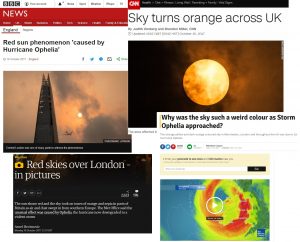By Dr Claire Ryder, Department of Meteorology, University of Reading

Monday’s red sun and the yellowy-orange sky produced an eerie atmosphere, and some beautiful photos, but what was the cause?
We’re used to seeing red skies at sunset, or even at dawn if we’re up early enough, but a red sun throughout the day is an extremely unusual event over the UK. A few unusual events combined this week to give us a blood-red sun for much of the day.
Firstly, we were under the effect of southerly air flow, associated with ex-hurricane Ophelia. While the centre of the storm was out to the west, central and southern England had relatively cloud-free skies allowing the sun to be seen.
Secondly, this southerly airflow brought both Saharan dust, whipped up by strong winds over desert surfaces, and smoke particles from wildfires over Portugal and Spain, lofted to high altitudes and transported our way. The combination of these two types of particles in the atmosphere then led to the red sun and orange skies.
Normally air molecules in the atmosphere scatter blue light most efficiently, making the sky appear a blue colour. At sunset and sunrise, sunlight takes a longer path through the atmosphere, and pollution particles are able to scatter red light more efficiently, making the sky appear red. This isn’t normally possible while the sun is high in the sky, as the pollution layers are not thick enough to have an impact. However, on Monday, the combined amounts of smoke and dust particles were high enough to scatter lots of red light throughout the day.
The redness of the sky can be affected by how large and how absorbing both the desert dust and smoke particles are. Current research at the University of Reading is investigating how recently-discovered very large dust particles measured over the Sahara desert might impact weather, climate and satellite measurements of dust from space, and how smoke particle emissions from Amazonian fires might impact South American climate and clouds. For example, dust storms transported over the Atlantic Ocean can alter sea surface temperatures by blocking out sunlight, and this can have an impact on Atlantic hurricane development.
The very particular set of atmospheric conditions required to turn the sun and sky red coincidentally came on the 30th anniversary of the great storm of 1987 and BBC weather presenter Michael Fish’s infamous remark dismissing talk of a hurricane. The combination of stories on the anniversary, the ex-hurricane and atmospheric dust ensured conversation was buzzing between academics here in the Department of Meteorology, and Reading is continuing to lead research on the latter two to better understand such phenomena in the future.
